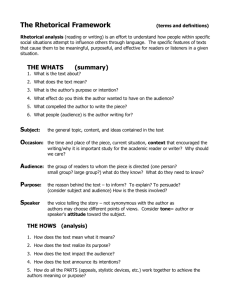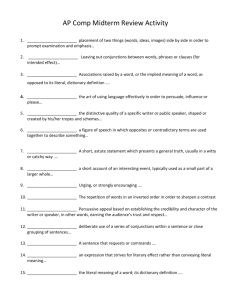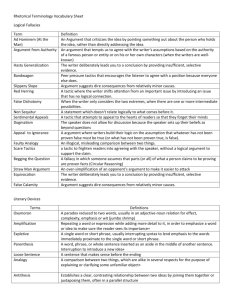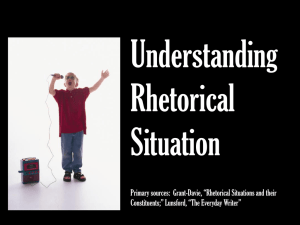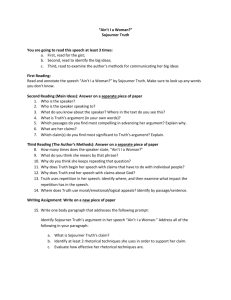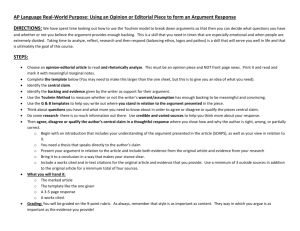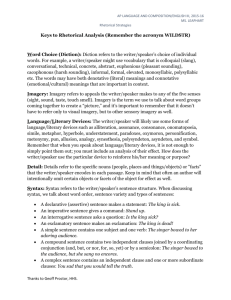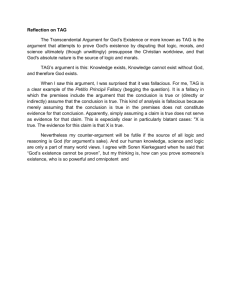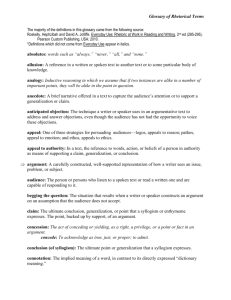Midterm Terminology 2015
advertisement
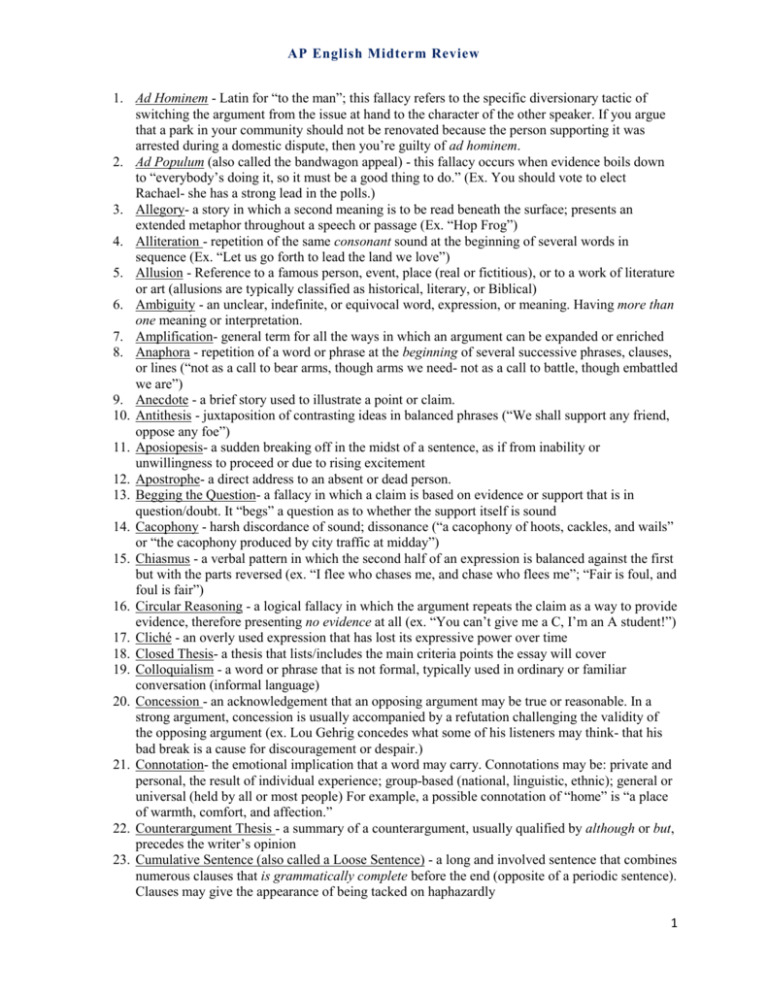
AP English Midterm Review 1. Ad Hominem - Latin for “to the man”; this fallacy refers to the specific diversionary tactic of switching the argument from the issue at hand to the character of the other speaker. If you argue that a park in your community should not be renovated because the person supporting it was arrested during a domestic dispute, then you’re guilty of ad hominem. 2. Ad Populum (also called the bandwagon appeal) - this fallacy occurs when evidence boils down to “everybody’s doing it, so it must be a good thing to do.” (Ex. You should vote to elect Rachael- she has a strong lead in the polls.) 3. Allegory- a story in which a second meaning is to be read beneath the surface; presents an extended metaphor throughout a speech or passage (Ex. “Hop Frog”) 4. Alliteration - repetition of the same consonant sound at the beginning of several words in sequence (Ex. “Let us go forth to lead the land we love”) 5. Allusion - Reference to a famous person, event, place (real or fictitious), or to a work of literature or art (allusions are typically classified as historical, literary, or Biblical) 6. Ambiguity - an unclear, indefinite, or equivocal word, expression, or meaning. Having more than one meaning or interpretation. 7. Amplification- general term for all the ways in which an argument can be expanded or enriched 8. Anaphora - repetition of a word or phrase at the beginning of several successive phrases, clauses, or lines (“not as a call to bear arms, though arms we need- not as a call to battle, though embattled we are”) 9. Anecdote - a brief story used to illustrate a point or claim. 10. Antithesis - juxtaposition of contrasting ideas in balanced phrases (“We shall support any friend, oppose any foe”) 11. Aposiopesis- a sudden breaking off in the midst of a sentence, as if from inability or unwillingness to proceed or due to rising excitement 12. Apostrophe- a direct address to an absent or dead person. 13. Begging the Question- a fallacy in which a claim is based on evidence or support that is in question/doubt. It “begs” a question as to whether the support itself is sound 14. Cacophony - harsh discordance of sound; dissonance (“a cacophony of hoots, cackles, and wails” or “the cacophony produced by city traffic at midday”) 15. Chiasmus - a verbal pattern in which the second half of an expression is balanced against the first but with the parts reversed (ex. “I flee who chases me, and chase who flees me”; “Fair is foul, and foul is fair”) 16. Circular Reasoning - a logical fallacy in which the argument repeats the claim as a way to provide evidence, therefore presenting no evidence at all (ex. “You can’t give me a C, I’m an A student!”) 17. Cliché - an overly used expression that has lost its expressive power over time 18. Closed Thesis- a thesis that lists/includes the main criteria points the essay will cover 19. Colloquialism - a word or phrase that is not formal, typically used in ordinary or familiar conversation (informal language) 20. Concession - an acknowledgement that an opposing argument may be true or reasonable. In a strong argument, concession is usually accompanied by a refutation challenging the validity of the opposing argument (ex. Lou Gehrig concedes what some of his listeners may think- that his bad break is a cause for discouragement or despair.) 21. Connotation- the emotional implication that a word may carry. Connotations may be: private and personal, the result of individual experience; group-based (national, linguistic, ethnic); general or universal (held by all or most people) For example, a possible connotation of “home” is “a place of warmth, comfort, and affection.” 22. Counterargument Thesis - a summary of a counterargument, usually qualified by although or but, precedes the writer’s opinion 23. Cumulative Sentence (also called a Loose Sentence) - a long and involved sentence that combines numerous clauses that is grammatically complete before the end (opposite of a periodic sentence). Clauses may give the appearance of being tacked on haphazardly 1 AP English Midterm Review 24. Deductive Reasoning (also called deduction) - a logical process wherein the writer reaches a conclusion by starting with a general principle or universal truth (a major premise) and applying it to a specific case (a minor premise). The process of deduction is usually demonstrated in the form of a syllogism: a. Major Premise: Exercise contributes to better health b. Minor Premise: Yoga is a type of exercise c. Conclusion: Yoga contributes to better health 25. Denotation- the explicit or direct meaning of a word or expression (the dictionary definition) 26. Diatribe- Bitter, abusive criticism or denunciation of a person, group, organization, idea, etc. 27. Diction- the writer’s/speaker’s choice of words 28. Didactic - writing which teaches a specific lesson or moral to provide a correct model of behavior 29. Digression - a passage or section that deviates (moves away) from the central theme in speech or writing; straying away from the main point under discussion 30. Direct Address- the use of a term or name for the person spoken to, as in securing the attention of that person; directly addressing the audience/reader. 31. Dramatic Irony- when the reader/audience knows something that the characters do not 32. Editorial “we” – when the speaker/ writer includes himself in the group using “we,” “us” or “our” 33. Enumeration- listing of items/ideas in order, often by naming steps such as first, second, etc. 34. Epiphora- a stylistic device in which a word or a phrase is repeated at the end of several successive clauses 35. Ethos- an appeal to the speaker’s/ writer’s credibility and good character 36. Euphemism- substitution of an inoffensive term for one considered unpleasant and/or offensive (ex. “veal” instead of “tender dead flesh of a baby cow”; “Friendly fire” instead of “you killed your comrade in battle”; “glistening” instead of “sweating”) 37. Euphony- agreeableness of sound; pleasing effect to the ear, especially a pleasant sounding or harmonious combination or succession of words (ex. “the majestic euphony of Milton's poetry”) 38. Exhortation- discourse that provides advice or warning to do what is proper and required (ex. Martin Luther King Jr.’s “I Have a Dream” speech) 39. Expansion- development or full treatment of a topic with use of several examples (Ex.Thoreau’s “Civil Disobedience”) 40. Fallacy- potential vulnerabilities or weaknesses in an argument. They often arise from a failure to make a logical connection between the claim and the evidence used to support it. 41. False Dilemma (also called the “either/or” fallacy) – a fallacy in which the speaker presents two extremes as the only possible choices (ex. “Either we raise taxes or our grandchildren will be mired in debt.”) 42. Faulty analogy- a fallacy that compares two things that are not comparable 43. Hasty generalization- a faulty conclusion is reached due to inadequate evidence 44. Horative sentence- a sentence that exhorts, urges, entreats, implores, or calls to action 45. Hyperbole - an extreme exaggeration not intended to be taken literally, as in “to wait an eternity.” 46. Idiom - a common phrase or expression (often a cliché) that is not meant to be taken literally (ex. “woke up on the wrong side of the bed,” “it’s raining cats and dogs,” “kicked the bucket”) 47. Imagery- descriptive language that appeals to one or more of the five senses 48. Imperative sentence - sentence used to give a command 49. Inductive reasoning (also called induction) – a form of reasoning that moves from specific observations to a general conclusion; not as reliable as deductive reasoning 50. Invective- a discourse that casts blame on someone or something 51. Juxtaposition - two contrasting objects, ideas, etc. placed side by side 52. Litotes- a form of an understatement in which an affirmative is expressed by negating its opposite (i.e. “you won’t be sorry” = “you’ll be glad”; “not too bad” = “good”; “I’m not as young as a I used to be” = “I’m old”) 53. Logos- an appeal to the audience/reader’s sense of logic 2 AP English Midterm Review 54. Metaphor- comparing two unlike objects, ideas, etc. without using “like” or “as.” A direct comparison 55. Metonymy- a figure of speech in which a closely related term is used in place of the word (i.e. referring to businessmen as “suits” or referring to the king as “the crown”) 56. Motif- any recurring object, idea, place, symbol, etc. throughout a work of literature 57. Open Thesis- a thesis that does not list all the criteria points the writer intends to cover in an essay 58. Oxymoron- juxtaposition of two contrasting terms (“bitter sweet”) 59. Paradox- a phrase that seems contradictory at first but expresses a deeper truth/meaning when examined further (i.e. “War is peace”) 60. Paralipsis - drawing attention to something by claiming not to mention it (Ex. I won’t mention his criminal record, but Mayor Miller should reconsider running for re-election.) 61. Parallelism- similarity of structure in a pair or series of related words, phrases, or clauses 62. Pathos- an appeal to the audience/reader’s sense of emotion 63. Periodic Sentence- a long and frequently involved sentence, marked by suspended syntax, in which the sentence is not completed until the final word--usually with an emphatic climax (opposite of the cumulative sentence) 64. Periphrasis- excessively wordy; using longer phrasing than necessary 65. Persona- Greek for “mask.” The face or character that a speaker shows to his or her audience. 66. Polemic- Greek for “hostile.” An aggressive argument that tries to establish superiority of one opinion above all others. Polemics generally do not concede that an opposing opinion have nay merit 67. Propaganda- the spread of ideas and information to further a cause. In its negative sense, propaganda is the use of rumors, lies, disinformation, and scare tactics in order to damage or promote a cause 68. Quantitative Evidence - includes evidence that can be measured, cited, counted, or otherwise represented in numbers (ex. statistics, surveys, polls, census information) 69. Refutation- disproves the opposing argument 70. Rhetoric- the art of persuasion and argumentation; discourse meant to affect/influence opinion 71. Rhetorical Question- asked just for effect or to lay emphasis on some point discussed when no real answer is expected. A rhetorical question may have an obvious answer but the questioner asks rhetorical questions to lay emphasis to the point. 72. Satire- a technique employed by writers to expose and criticize foolishness and corruption of an individual or a society by using humor, irony, exaggeration or ridicule. It intends to improve humanity by criticizing its follies and foibles. 73. Simile- a figure of speech that makes a comparison, showing similarities between two different things using “like” or “as.” 74. Situational Irony- most broadly defined as a situation where the outcome is incongruous with what was expected (an unexpected occurrence) 75. SOAPS (Subject, Occasion, Audience, Purpose, Speaker) – acronym used to remember the various elements that make up the rhetorical situation. 76. Straw Man Fallacy- occurs when a speaker chooses a deliberately poor or oversimplified example in order to ridicule and refute an idea 77. Symbol- using an object or a word to represent an abstract idea. An action, person, place, word, or object can all have a symbolic meaning. 78. Synecdoche- a figure of speech in which a part of something represents the whole (i.e. “wheels” represents a car) 79. Synesthesia- appealing to more than one of the senses (sight, sound, taste, touch, smell) simultaneously (ex. “loud colors”; “frozen silence”) 80. Syntax- refers to the ways words are combined into sentences; sentence structure 3 AP English Midterm Review 81. Testimony- an individual’s account of an event or state of affairs (could be expert testimony, witness testimony, personal testimony, etc.) 82. Tone- the author’s attitude toward the subject matter 83. Tricolon- a rhetorical term for a series of three parallel words, phrases, or clauses (ex. “A happy life is one spent learning, earning, and yearning”) 84. Trope- the generic name for all figures of speech (simile, metaphor, metonymy, synecdoche, etc.) 85. Understatement- when a writer deliberately makes a situation seem less important or serious than it is 86. Verbal Irony- irony in which a person says or writes one thing and means another, or uses words to convey a meaning that is the opposite of the literal meaning. 87. Zeugma- use of two different words in a grammatically similar way that produces different, often incongruous, meanings; use of one word to modify two or more different ideas (i.e. “He opened his mind and his wallet”; “The farmers grew potatoes, peanuts, and bored”) 4
